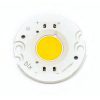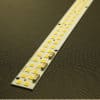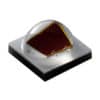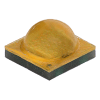Led Technology
What is MacAdam Ellipse?
MacAdam Ellipse: A Comprehensive Guide
The MacAdam Ellipse is an important concept in the field of colorimetry and plays a significant role in the understanding of human perception of color. This article aims to provide an exhaustive explanation of the MacAdam Ellipse, its applications, and relevance.
1. Introduction to Color Spaces
To understand the MacAdam Ellipse, one must first comprehend the concept of color spaces. A color space is a specific organization of colors, typically represented in a three-dimensional form. The CIE 1931 color space is the standard color space that forms the basis for understanding the MacAdam Ellipse.
2. The CIE 1931 Chromaticity Diagram
The CIE 1931 Chromaticity Diagram is a graph that maps all perceivable colors in a two-dimensional space. The x and y coordinates represent the chromaticity values, while brightness is represented in a separate dimension.
3. MacAdam Ellipse Definition
In the 1940s, David MacAdam conducted experiments to study how humans perceive color differences. He discovered that the perceptual difference between colors isn’t uniform across the CIE 1931 chromaticity diagram.
The MacAdam Ellipse represents regions in the chromaticity diagram where colors are indistinguishable to the average human eye. Each ellipse contains colors that are perceptually the same, and the size and orientation of the ellipse vary across the diagram.
3.1. Key Features
- Shape: The ellipses are not perfect circles; their shape varies depending on the location in the chromaticity diagram.
- Size: The size indicates the just-noticeable difference (JND) in color. A larger ellipse means a larger area where color differences are not perceptible.
- Orientation: The orientation of the ellipses also varies, reflecting the non-uniformity of human color perception.
4. Applications
4.1. Color Quality Control
The use of MacAdam Ellipses in color quality control within manufacturing environments is a sophisticated application that leverages human color perception to maintain product quality. Here’s an in-depth exploration of how this concept is applied in various contexts:
4.1.1. Importance of Color Quality Control
- Brand Consistency: Consistent color is vital for brand identity. Any color variations can impact customer perception and trust.
- Product Aesthetics: In products where aesthetics are crucial, such as textiles, automotive finishes, or electronics, maintaining consistent color is essential for market appeal.
4.1.2. MacAdam Ellipses in Manufacturing
- Defining Tolerance: MacAdam Ellipses help define the acceptable color deviation range. Products with color coordinates inside a specific ellipse are considered acceptable, maintaining perceptual uniformity.
- LED Binning: Similar to its application in lighting design, MacAdam Ellipses are used to bin LEDs in manufacturing, ensuring that LEDs within the same bin appear the same color to the human eye.
4.1.3. Measurement and Assessment Tools
- Spectrophotometers: Instruments like spectrophotometers, aligned with the MacAdam Ellipse concept, can measure the color of an object and determine if it falls within acceptable parameters.
- Visual Inspection: Trained inspectors can visually assess products using MacAdam Ellipse guidelines to ensure that batches match within acceptable tolerances.
4.1.4. Challenges in Color Quality Control
- Material Variations: Different materials can interact with color differently. Understanding how MacAdam Ellipses apply to various materials is a complex task.
- Environmental Factors: Lighting conditions can influence color perception. Standardizing these conditions in a manufacturing environment is crucial for accurate quality control.
4.1.5. Industry-Specific Applications
- Textiles and Fashion: Ensuring that fabrics used in clothing match precisely, especially in large production runs.
- Automotive Industry: In car manufacturing, MacAdam Ellipses help ensure that different parts, even if produced by different suppliers, match in color.
- Food Industry: Color consistency in food products can be vital for customer acceptance and perception of quality. MacAdam Ellipses guide the color consistency of items like beverages, snacks, and processed foods.
- Cosmetics: In the production of makeup and personal care products, color matching is essential for consumer satisfaction.
4.1.6. Future Directions
- Automation and AI: Automated systems utilizing artificial intelligence and machine learning, built on the understanding of MacAdam Ellipses, may further refine color quality control.
- Integration with Supply Chain: Ensuring color consistency across various stages of the supply chain, aided by the principles of MacAdam Ellipses, could further enhance product quality and efficiency.
4.2. Display Calibration
Display calibration is a critical process that ensures accurate color reproduction on various digital screens such as televisions, computer monitors, and mobile devices. The MacAdam Ellipse, representing human perception of color differences, plays a significant role in this calibration process. Let’s explore this relationship in detail:
4.2.1. Importance of Accurate Color Reproduction
- Visual Consistency: Ensuring that colors appear the same across different devices is vital for visual consistency, especially in professional fields like graphic design, photography, and videography.
- User Experience: Accurate color reproduction enhances the viewing experience, allowing content to be displayed as intended by the creators.
4.2.2. Understanding Color Tolerance
- Defining Color Differences: MacAdam Ellipses define the just-noticeable differences (JND) in color perception. This information guides calibration by determining acceptable color tolerances.
- Handling Variation: Not all parts of the color spectrum are perceived equally by the human eye. MacAdam Ellipses help in understanding where color differences are more or less noticeable.
4.2.3. Calibration Techniques
- Software Calibration: Utilizing software that understands the MacAdam Ellipse, calibration tools can fine-tune the display settings to align with human color perception.
- Hardware Calibration: Some professional-grade monitors come with hardware calibration options that take into account MacAdam Ellipses to provide highly accurate color rendering.
4.2.4. Industry Standards and Practices
- Setting Standards: MacAdam Ellipses contribute to defining industry standards for color accuracy, guiding manufacturers, and content creators alike.
- Quality Assurance: In manufacturing, understanding MacAdam Ellipses ensures that the displays meet specific quality benchmarks for color reproduction.
4.2.5. Challenges and Limitations
- Complexity of Perception: Human perception of color is complex and varies among individuals. MacAdam Ellipses provide a general guide, but individual variations may still occur.
- Technological Limitations: Not all displays can achieve the same level of accuracy. Budget constraints and technical limitations might restrict the level of calibration possible.
4.2.6. Future Directions and Innovation
- Adaptive Displays: Future technology may enable dynamic adaptation to individual color perception, utilizing the principles of the MacAdam Ellipse to provide personalized viewing experiences.
- Integration with Emerging Technologies: As augmented reality (AR) and virtual reality (VR) evolve, understanding and applying MacAdam Ellipses will be vital in creating immersive and visually coherent environments.
4.3. Lighting Design
In the context of lighting design, the MacAdam Ellipse serves as a crucial tool that guides designers in selecting colors that will appear consistent and uniform to the human eye. Below are the various aspects of how MacAdam Ellipses are applied in lighting design:
4.3.1. Color Consistency
- Understanding Variation: MacAdam Ellipses help in understanding the perceptible color variations. A small change in chromaticity coordinates might create a noticeable difference in one part of the color space but might be insignificant in another.
- Ensuring Uniformity: By considering the variations within the MacAdam Ellipse, designers can ensure that different light sources in the same environment appear uniform, even if they have slight differences in chromaticity coordinates.
4.3.2. Selection of Light Sources
- LED Binning: MacAdam Ellipses are commonly used in the LED industry in a process known as ‘binning.’ LEDs are grouped or ‘binned’ according to their color characteristics. A ‘one-step MacAdam Ellipse,’ for example, includes LEDs that have color differences indistinguishable to the human eye.
- Color Matching: In a space where multiple light sources are used, MacAdam Ellipses help designers select bulbs that fall within the same or adjacent ellipses, thus ensuring visual color harmony.
4.3.3. Design Aesthetics
- Creating Ambiance: Understanding the perceptible color differences helps designers create the desired ambiance in a space. By selecting colors within a specific MacAdam Ellipse, a designer can evoke specific moods or feelings.
- Architectural Integration: MacAdam Ellipses allow designers to match or contrast lighting with architectural elements. The understanding of how colors will be perceived aids in integrating lighting as a coherent part of the overall design.
4.3.4. Quality Control
- Setting Standards: MacAdam Ellipses provide a standard measure for manufacturers and designers to define the acceptable color variation in the lighting products.
- Compliance and Regulation: Some regions and industries have specific regulations concerning color consistency. Utilizing MacAdam Ellipses ensures that the lighting design meets these requirements.
4.3.5. Innovations in Technology
- Smart Lighting: With advancements in smart lighting technology, understanding the MacAdam Ellipse helps in creating dynamic lighting systems that can adjust to human perception, providing optimal visual comfort.
- Energy Efficiency: By allowing precise control over color output, MacAdam Ellipses enable designers to use energy more efficiently without compromising on aesthetic appeal.
5. Further Developments
The original study by MacAdam has been expanded and refined over the years. Modern technology and further research have led to more precise understanding and utilization of these principles in various industries.
6. Conclusion
The MacAdam Ellipse is not just a historical curiosity but a fundamental tool in understanding human color perception. From quality control in manufacturing to sophisticated digital display technology, the principles encapsulated in these simple geometric figures continue to shape our colorful world.
By appreciating the complexities and subtleties of how we perceive color, we open the door to innovation, efficiency, and artistry in countless fields. The enduring relevance of the MacAdam Ellipse serves as a testament to the intricate relationship between science, technology, and the human sensory experience.

















